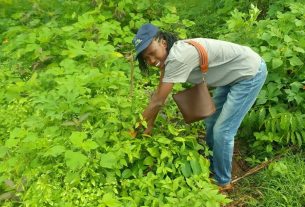The cover image for our December issue shows germination day one of European Hazel, Corylus avellana. The yellow radicle breaks through the nut wall and elongates into the substrate over the following fortnight. This image relates to the article, Biological Flora of Britain and Ireland: Corylus avellana, by Damien Hicks. Here, Damien tells us the story behind the image:
The seeds of Corylus avellana are usually not reliably stored for more than a year under ambient conditions without losing viability on drying. For germination they require a cold stratification period of two to six months of prechilling, which stimulates the removal of the block to gibberellin biosynthesis as the seed encounters higher temperatures.
So if like me you are more used to eating hazelnuts than successfully coaxing them to become living plants, you may have a feel for my fear of letting down the Journal of Ecology with zero germinated seeds! In particular, a false start in December of a single germination, doomed at the ‘wrong’ time of year, necessitated a lot of patience from colleagues as I dejectedly stared at the seed tray for the next month and a half.
Happily in February the majority of the seeds germinated and then elongated into the soil over the following two months. In April the stem of the embryo plants (the hypocotyl) began to emerge, clothed in the characteristic glandular hairs of the young parts of C. avellana.
The abundance of C. avellana in nutcracker bowls at this time of year might offer an emergency supply (should you have neglected to prepare a speech, or be unexpectedly nominated to do a turn) of biological specimens to wow the party on the morphology of hazelnuts. The large scar at the base of the nut indicates the zone by which the fruit adhered to the tree (at the characteristic ‘cupule’ of this species), which has grown in breadth in the 3 months to its dispersal by wind or animal in October. The extent and direction of that growth are indicated by the radiating stripes covering the surface of the scar, marking the remains of disrupted soft tissue (the parenchyma) and vascular bundles. The surface of the scar can be filed down a little, to reveal a small hole in the centre which runs through to the inside of the hard shell, indicating the passage by which the developing seed was fed by the tree.
Careful cracking open of the hazelnut reveals the route of the vascular bundle through the interior and up along a ridge (the raphe) of the seed, attaching at the apex below the remnants of the style of the fruit. The force needed to crack the shell by hand gives an indication of the amount of inward pressure exerted by the soft developing embryo to achieve what is shown in the cover picture.
Now to the final task, of tree planting.



